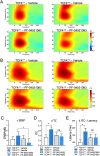Evaluation of Nav1.8 as a therapeutic target for Pitt Hopkins Syndrome
- PMID: 36224259
- PMCID: PMC9812766
- DOI: 10.1038/s41380-022-01811-4
Evaluation of Nav1.8 as a therapeutic target for Pitt Hopkins Syndrome
Abstract
Pitt Hopkins Syndrome (PTHS) is a rare syndromic form of autism spectrum disorder (ASD) caused by autosomal dominant mutations in the Transcription Factor 4 (TCF4) gene. TCF4 is a basic helix-loop-helix transcription factor that is critical for neurodevelopment and brain function through its binding to cis-regulatory elements of target genes. One potential therapeutic strategy for PTHS is to identify dysregulated target genes and normalize their dysfunction. Here, we propose that SCN10A is an important target gene of TCF4 that is an applicable therapeutic approach for PTHS. Scn10a encodes the voltage-gated sodium channel Nav1.8 and is consistently shown to be upregulated in PTHS mouse models. In this perspective, we review prior literature and present novel data that suggests inhibiting Nav1.8 in PTHS mouse models is effective at normalizing neuron function, brain circuit activity and behavioral abnormalities and posit this therapeutic approach as a treatment for PTHS.
© 2022. The Author(s).
Conflict of interest statement
The authors declare no competing interests.
Figures



Similar articles
-
Disordered breathing in a Pitt-Hopkins syndrome model involves Phox2b-expressing parafacial neurons and aberrant Nav1.8 expression.Nat Commun. 2021 Oct 13;12(1):5962. doi: 10.1038/s41467-021-26263-2. Nat Commun. 2021. PMID: 34645823 Free PMC article.
-
Repurposing the Dihydropyridine Calcium Channel Inhibitor Nicardipine as a Nav1.8 Inhibitor In Vivo for Pitt Hopkins Syndrome.Pharm Res. 2020 Jun 11;37(7):127. doi: 10.1007/s11095-020-02853-5. Pharm Res. 2020. PMID: 32529312 Free PMC article.
-
Molecular and Cellular Function of Transcription Factor 4 in Pitt-Hopkins Syndrome.Dev Neurosci. 2021;43(3-4):159-167. doi: 10.1159/000516666. Epub 2021 Jun 16. Dev Neurosci. 2021. PMID: 34134113 Free PMC article. Review.
-
Common Pathophysiology in Multiple Mouse Models of Pitt-Hopkins Syndrome.J Neurosci. 2018 Jan 24;38(4):918-936. doi: 10.1523/JNEUROSCI.1305-17.2017. Epub 2017 Dec 8. J Neurosci. 2018. PMID: 29222403 Free PMC article.
-
An attempt to explain what intrinsically disordered TCF4 does in its spare time when PTHS-related mutations prevent it from doing its job.Cell Commun Signal. 2025 Jun 1;23(1):258. doi: 10.1186/s12964-025-02265-1. Cell Commun Signal. 2025. PMID: 40452023 Free PMC article. Review.
Cited by
-
Effects of pH on opioid receptor activation and implications for drug design.Biophys J. 2024 Dec 17;123(24):4158-4166. doi: 10.1016/j.bpj.2024.07.007. Epub 2024 Jul 5. Biophys J. 2024. PMID: 38970252 Free PMC article. Review.
-
From Genotype to Phenotype of Polish Patients with Pitt-Hopkins Syndrome concerning the Quality of Life and Family Functioning.J Clin Med. 2024 Apr 29;13(9):2605. doi: 10.3390/jcm13092605. J Clin Med. 2024. PMID: 38731134 Free PMC article.
-
The TCF4 Gene Regulates Apoptosis of Corneal Endothelial Cells in Fuchs Endothelial Corneal Dystrophy.Invest Ophthalmol Vis Sci. 2025 Mar 3;66(3):16. doi: 10.1167/iovs.66.3.16. Invest Ophthalmol Vis Sci. 2025. PMID: 40048186 Free PMC article.
-
Psychiatric risk gene Transcription Factor 4 (TCF4) regulates the density and connectivity of distinct inhibitory interneuron subtypes.Mol Psychiatry. 2023 Nov;28(11):4679-4692. doi: 10.1038/s41380-023-02248-z. Epub 2023 Sep 28. Mol Psychiatry. 2023. PMID: 37770578 Free PMC article.
-
A novel co-target of ACY1 governing plasma membrane translocation of SphK1 contributes to inflammatory and neuropathic pain.iScience. 2023 May 28;26(6):106989. doi: 10.1016/j.isci.2023.106989. eCollection 2023 Jun 16. iScience. 2023. PMID: 37378314 Free PMC article.
References
-
- Steinbusch CVM, van Roozendaal KEP, Tserpelis D, Smeets EEJ, Kranenburg-de Koning TJ, de Waal KH, et al. Somatic mosaicism in a mother of two children with Pitt-Hopkins syndrome. Clin Genet. 2013;83:73–7. - PubMed
-
- Kousoulidou L, Tanteles G, Moutafi M, Sismani C, Patsalis PC, Anastasiadou V. 263.4 kb deletion within the TCF4 gene consistent with Pitt-Hopkins syndrome, inherited from a mosaic parent with normal phenotype. Eur J Med Genet. 2013;56:314–8. - PubMed
-
- Zweier C, Sticht H, Bijlsma EK, Clayton-Smith J, Boonen SE, Fryer A, et al. Further delineation of Pitt-Hopkins syndrome: phenotypic and genotypic description of 16 novel patients. J Med Genet. 2008;45:738–44. - PubMed
-
- Amiel J, Rio M, de Pontual L, Redon R, Malan V, Boddaert N, et al. Mutations in TCF4, encoding a class I basic helix-loop-helix transcription factor, are responsible for Pitt-Hopkins syndrome, a severe epileptic encephalopathy associated with autonomic dysfunction. Am J Hum Genet. 2007;80:988–93. - PMC - PubMed
-
- Sepp M, Pruunsild P, Timmusk T. Pitt-Hopkins syndrome-associated mutations in TCF4 lead to variable impairment of the transcription factor function ranging from hypomorphic to dominant-negative effects. Hum Mol Genet. 2012;21:2873–88. - PubMed
Publication types
MeSH terms
Substances
Supplementary concepts
Grants and funding
LinkOut - more resources
Full Text Sources

